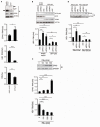Interferon-alpha responsible EPN3 regulates hepatitis B virus replication
- PMID: 35935763
- PMCID: PMC9354525
- DOI: 10.3389/fmed.2022.944489
Interferon-alpha responsible EPN3 regulates hepatitis B virus replication
Abstract
Hepatitis B virus (HBV) infection remains a major health problem worldwide, and the current antiviral therapy, including nucleoside analogs, cannot achieve life-long cure, and clarification of antiviral host immunity is necessary for eradication. Here, we found that a clathrin-binding membrane protein epsin3 (EPN3) negatively regulates the expression of HBV RNA. EPN3 expression was induced by transfection of an HBV replicon plasmid, and reduced HBV-RNA level in hepatic cell lines and murine livers hydrodynamically injected with the HBV replicon plasmid. Viral RNA reduction by EPN3 was dependent on transcription, and independent from epsilon structure of viral RNA. Viral RNA reduction by overexpression of p53 or IFN-α treatment, was attenuated by knockdown of EPN3, suggesting its role downstream of IFN-α and p53. Taken together, this study demonstrates the anti-HBV role of EPN3. The mechanism how it decreases HBV transcription is discussed.
Keywords: AID; EPN3; HBV; IFN-α; p53.
Copyright © 2022 Li, Wang, Zhou, Fu, Zhang, Sun, Yang, Bai, Dai, Xu, Cui, Zhao, Zhang, Wang, Li, Muramatsu, Wakae and Liu.
Figures






Similar articles
-
Interferon-inducible MX2 is a host restriction factor of hepatitis B virus replication.J Hepatol. 2020 May;72(5):865-876. doi: 10.1016/j.jhep.2019.12.009. Epub 2019 Dec 18. J Hepatol. 2020. PMID: 31863794
-
Interferon-stimulated gene of 20 kDa protein (ISG20) degrades RNA of hepatitis B virus to impede the replication of HBV in vitro and in vivo.Oncotarget. 2016 Oct 18;7(42):68179-68193. doi: 10.18632/oncotarget.11907. Oncotarget. 2016. PMID: 27626689 Free PMC article.
-
Osteopetrosis-Associated Transmembrane Protein 1 Recruits RNA Exosome To Restrict Hepatitis B Virus Replication.J Virol. 2020 May 18;94(11):e01800-19. doi: 10.1128/JVI.01800-19. Print 2020 May 18. J Virol. 2020. PMID: 32188736 Free PMC article.
-
Management of viral hepatitis B.J Gastroenterol Hepatol. 2002 Feb;17 Suppl:S125-45. doi: 10.1046/j.1440-1746.17.s1.3.x. J Gastroenterol Hepatol. 2002. PMID: 12000599 Review.
-
Intracellular interferon signalling pathways as potential regulators of covalently closed circular DNA in the treatment of chronic hepatitis B.World J Gastroenterol. 2021 Apr 14;27(14):1369-1391. doi: 10.3748/wjg.v27.i14.1369. World J Gastroenterol. 2021. PMID: 33911462 Free PMC article. Review.
Cited by
-
Host transcriptome response to Mycoplasma bovis and bovine viral diarrhea virus in bovine tissues.BMC Genomics. 2025 Apr 10;26(1):361. doi: 10.1186/s12864-025-11549-2. BMC Genomics. 2025. PMID: 40211134 Free PMC article.
-
Peptide YY inhibits transcription and replication of hepatitis B virus by suppressing promoter/enhancer activity.Virus Genes. 2023 Oct;59(5):678-687. doi: 10.1007/s11262-023-02017-8. Epub 2023 Jun 28. Virus Genes. 2023. PMID: 37380814
References
LinkOut - more resources
Full Text Sources
Research Materials
Miscellaneous

